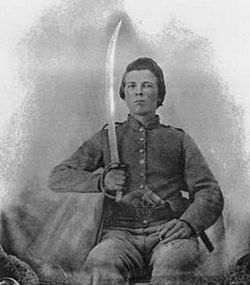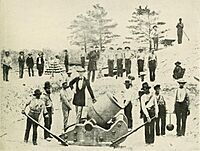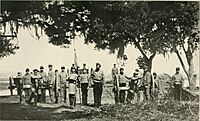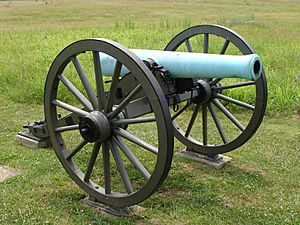Confederate States Army facts for kids
Quick facts for kids Confederate States Army |
|
|---|---|

Battle flag of the Army of Northern Virginia
|
|
| Founded | February 28, 1861 |
| Country | |
| Type | Army |
| Size | 1,082,119 total who served
|
| Part of | |
| Colors | Cadet Gray |
| March | "Dixie" |
| Conflicts | |
| Disbanded | May 26, 1865 |
| Commanders | |
| Commander in Chief | Jefferson Davis (1861–65) |
| General in Chief | General Robert E. Lee (1865) |
The Confederate States Army (CSA) was organized in February 1861 to defend the newly formed Confederate States of America during the American Civil War. Somewhere between 750,000 and 1.2 million soldiers served the Confederacy in one form or another. The exact numbers are not known because of incomplete and destroyed records. Although it won a large number of battles the Confederate Army was not able to win the war. It could not overcome the Union army's larger numbers and better resources. On April 9, 1865, General Robert E. Lee surrendered what was left of the Army of Northern Virginia to General Ulysses S. Grant at Appomattox Court House, Virginia. While his army was only a part of the total Confederate army, his surrender marked the end of the Confederacy. On June 23, 1865, Georgia's Stand Watie became the last Confederate general to surrender.
Contents
Makeup
Much of the design of the Confederate States Army was based on the structure and customs of the U.S. Army. Both armies consisted mainly of infantry, cavalry and artillery units. While the structure of the two armies was almost the same, the sizes of the units within the army varied. Many Confederate officers were graduates of West Point just like Union officers. Regiments were usually numbered and named for the state where they were first organized and where most of the soldiers came from. Brigades were usually named after their commanders (past or present). For example, the Stonewall Brigade was named for its commanding general, Stonewall Jackson.
The Confederate Army was made up of three parts; the Army of the Confederate States of America (ACSA, smallest but intended to be the permanent, regular army), the Provisional Army of the Confederate States (PACS, or "volunteer" Army, to be disbanded after the war), and the various Southern state militias. The Confederate Constitution called for the President, Jefferson Davis to be Commander-in-Chief of the army and navy. It did not call for a commanding general of the army but several generals serves as advisors to President Davis.
Structure
- A regiment was the basic unit in battle. At the start of the war, a regiment was 1,000 men and was led by a colonel. Regiments were usually recruited from the same area so most soldiers and officers knew each other. Disease, desertion, and combat reduced the numbers considerably. Usually, instead of adding new recruits to a decimated regiment, a new regiment would be raised in its place.
- A brigade was from two to five regiments. Led by a brigadier general a brigade was usually from one branch of the army (infantry, cavalry or artillery).
- A division was two or more brigades. In the Confederate army, divisions could be as many as five or six brigades (Union army divisions were usually smaller). Divisions were commanded by a major general.
- A corps was two or more divisions. A corps usually included infantry, cavalry and artillery. That way a corps was independent and could conduct operations on its own.
- An army was two or more corps. A Corps or an army was usually led by the most senior major general or a general picked by Jefferson Davis.
Armies
The Confederate States Army included the following armies:
- The Army of Northern Virginia was one of the main forces of the Confederate Army in the east.
- The Confederate Army of the Shenandoah, after the First Battle of Bull Run it became part of the Confederate Army of the Potomac.
- The Army of the Peninsula was established May 26, 1861. On April 12, 1862, it was merged into the Army of Northern Virginia.
- The Confederate Army of the Northwest was an army early in the war. It was disbanded February 9, 1862.
- The Army of Central Kentucky. Was created in 1861. In March 1862 it was merged into the Army of Mississippi, which then became the Army of Tennessee
- The Army of New Mexico was a smaller army that operated in the New Mexico Territory in 1861 and 1862.
- The Army of the West was largely made up of the Missouri State Guard.
Confederate officers
Before the Civil War, many Confederate officers had served in the United States Army. When war broke out, 313 army officers resigned and became officers in the Confederate army. Lee was one of those who found it difficult to leave. Abraham Lincoln had offered him the position of commander-in-chief of the Union Army. But he could not fight against his native state of Virginia. He became a Major general of the Virginia militia and when Virginia Seceded, it became part of the regular army. Many militias elected their officers including field officers. When these units joined the Confederate army, their officers were commissioned. There were also a number of professional officers who came from Germany or Britain (just as there were in the Union army). But at the start of the war, few Southern officers had any real experience. Wealthy planters who owned 20 or more slaves were not required to serve in the army and many stayed home during the war. Some served in the Enlisted rank but many found it objectionable to serve under officers so poor they could not afford a single slave. Many Confederate officers kept a slave as a personal servant throughout the war.
Confederate soldiers
Confederate officers in general did not maintain discipline among their men. Many of their soldiers were illiterate and some did not know which was their left foot and which was their right. At the Battle of Gettysburg in 1863, even Lee complained about the lack of discipline in his army. Visiting foreign officials were shocked at lack of discipline and were amazed they could fight.
Confederate soldiers came from a few ethnic backgrounds. Most of their ancestors came from Scotland, England, Ireland and Wales. Some had ancestors from France and Southern Europe. In regiments such as the 33rd Texas Cavalry, many had Spanish ancestry. Some could even trace their roots back to Spanish Conquistadors. In the Deep South, the Cherokee Nation sent several regiments who fought as equals alongside other Confederate units.
The average Confederate soldier was in his early 20s. He was usually gaunt, unkempt and beards were common. His wool uniform was often torn and in rags. It often did not fit, especially if taken off a dead soldier. Most wore a white shirt under their wool jacket. Replacement uniforms were hard to get. They would often stain homespun (clothing made at home) with a dye made from walnuts. This gave their uniforms a yellowish-brown appearance they called "butternut". Many did not have shoes or shoes that fit. Those who did nailed horseshoes to the bottom to keep them from wearing through the sole. At first he carried a musket or flintlock rifle. Later in the war many carried the better Enfield rifles taken from dead Union soldiers. What the Rebel soldier lacked in supplies and equipment, he made up for in fighting spirit. Any boots, uniforms or supplies Union soldiers left behind or were captured were used by the Confederate soldiers. In camp, most of the tents were marked "U.S." Most of the Southern Artillery was also captured Union cannons.
Organization
Because of the destruction of any central repository of records in the capital at Richmond in 1865 and the comparatively poor record-keeping of the time, there can be no definitive number that represents the strength of the Confederate States Army. Estimates range from 500,000 to 2,000,000 soldiers who were involved at any time during the war. Reports from the C.S. War Department beginning at the end of 1861 indicated 326,768 men that year, 449,439 in 1862, 464,646 in 1863, 400,787 in 1864, and "last reports" showed 358,692. Estimates of enlistments throughout the war range from 1,227,890 to 1,406,180.
The following calls for soldiers were issued:
- March 6, 1861: 100,000 volunteers and militia
- January 23, 1862: 400,000 volunteers and militia
- April 16, 1862, the First Conscription Act: passed by the Confederate States Congress conscripted white men ages 18 to 35 for the duration of hostilities
- September 27, 1862, the Second Conscription Act: expanded the age range to 18 to 45, with implementation beginning on July 15, 1863
- February 17, 1864, the Third Conscription Act: expanded further to ages 17 to 50
- March 13, 1865, authorized finally up to 300,000 African American slaves as troops but was never fully implemented.
The C.S.A. was initially a (strategically) defensive army, and many soldiers were resentful when General Robert E. Lee led his Army of Northern Virginia across the Potomac River in his first invasion of the North in the Antietam campaign in Maryland in September 1862.
Command

The Confederate States Army did not have a formal overall military commander, or general in chief, until late in the war. The Confederate President, Jefferson Davis, himself a former U.S. Army officer and U.S. Secretary of War, served as commander-in-chief and provided the overall strategic direction for Confederate land and naval forces in both eastern and western theaters. The following men had varying degrees of control:
- Robert E. Lee was "charged with the conduct of military operations in the armies of the Confederacy" from March 13 to May 31, 1862. He was referred to as President Davis' military adviser but exercised broad control over the strategic and logistical aspects of the Army, a role similar in nature to the current Chief of Staff of the United States Army (not developed until beginning in the early 20th century). On June 1, he assumed command of the Army of Northern Virginia, which was considered the most important of all the Confederate field armies.
- Braxton Bragg was similarly "charged with the conduct of military operations in the armies of the Confederacy" from February 24, 1864 (after he was relieved of field command following the Battle of Chattanooga) to January 31, 1865. This role was a military advisory position under Davis.
- Lee was formally designated General in Chief of the Armies of the Confederate States by an act of Congress (January 23, 1865) and served in this capacity from January 31 to April 9, 1865.
The lack of centralized control was a strategic weakness for the Confederacy, and there are only a few examples of its armies acting in concert across multiple theaters to achieve a common objective. One instance occurred in late 1862 with Lee's invasion of Maryland, coincident with two other actions: Bragg's invasion of Kentucky and Earl Van Dorn's advance against Corinth, Mississippi. All three initiatives were unsuccessful, however. Georgia Governor Joseph E. Brown was an extreme case of a Southern States Rights advocate asserting control over Confederate soldiers: he defied the Confederate government's wartime policies and resisted the military draft. Believing that local troops should be used only for the defense of Georgia, Brown tried to stop Colonel Francis Bartow from taking Georgia troops out of the state to the First Battle of Bull Run.
Many of the Confederacy's senior military leaders (including Robert E. Lee, Albert Sidney Johnston, and James Longstreet) and even President Jefferson Davis, were former U.S. Army and, in smaller numbers, U.S. Navy officers who had been opposed to, disapproved of, or were at least unenthusiastic about secession, but resigned their U.S. commissions upon hearing that their states had left the Union. They felt that they had no choice but to help defend their homes. President Abraham Lincoln was exasperated to hear of such men who professed to love their country but were willing to fight against it.
Ranks and insignia
| Officer rank structure of the Confederate Army | ||||||||||
|---|---|---|---|---|---|---|---|---|---|---|
| General | Colonel | Lieutenant colonel | Major | Captain | First lieutenant | Second lieutenant | ||||
 |
||||||||||
There were four grades of general officer (general, lieutenant general, major general, and brigadier general), but all wore the same insignia regardless of grade. This was a decision made early in the conflict. The Confederate Congress initially made the rank of brigadier general the highest rank. As the war progressed, the other general-officer ranks were quickly added, but no insignia for them was created. (Robert E. Lee was a notable exception to this. He chose to wear the rank insignia of a colonel.) Only seven men achieved the rank of (full) general; the highest-ranking (earliest date of rank) was Samuel Cooper, Adjutant General and Inspector General of the Confederate States Army.
Officers' uniforms bore a braided design on the sleeves and kepi, the number of adjacent strips (and therefore the width of the lines of the design) denoting rank. The color of the piping and kepi denoted the military branch. The braid was sometimes left off by officers since it made them conspicuous targets. The kepi was rarely used, the common slouch hat being preferred for its practicality in the Southern climate.
| Enlisted rank structure | ||||||||||
|---|---|---|---|---|---|---|---|---|---|---|
| Sergeant Major | Quartermaster Sergeant | Ordnance Sergeant | First Sergeant | |||||||
 |
 |
 |
 |
|||||||
| Sergeant | Corporal | Musician | Private | |||||||
 |
 |
no insignia | no insignia | |||||||
Branch colors were used for the color of chevrons—blue for infantry, yellow for cavalry, and red for artillery. This could differ with some units, however, depending on available resources or the unit commander's desire. Cavalry regiments from Texas, for example, often used red insignia and at least one Texas infantry regiment used black.
The CSA differed from many contemporaneous armies in that all officers under the rank of brigadier general were elected by the soldiers under their command. The Confederate Congress authorized the awarding of medals for courage and good conduct on October 13, 1862, but wartime difficulties prevented the procurement of the needed medals. To avoid postponing recognition for their valor, those nominated for the awards had their names placed on a Roll of Honor, which would be read at the first dress parade after its receipt and be published in at least one newspaper in each state.
Supply and logistics
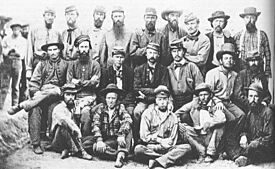
The supply situation for most Confederate armies was dismal, even when they were victorious on the battlefield. The central Confederate government was short of money so each state government had to supply its regiments. The lack of central authority and the ineffective railroads, combined with the frequent unwillingness or inability of Southern state governments to provide adequate funding, were key factors in the Confederate army's demise. The Confederacy early on lost control of most of its major river and ocean ports to capture or blockade. The road system was poor, and it relied more and more on a heavily overburdened railroad system. U.S. forces destroyed track, engines, cars, bridges and telegraph lines as often as possible, knowing that new equipment was unavailable to the Confederacy. Occasional raids into the North were designed to bring back money and supplies. In 1864, the Confederates burned down Chambersburg, a Pennsylvania city they had raided twice in the years before, due to its failure to pay an extortion demand.
As a result of severe supply problems, as well as the lack of textile factories in the Confederacy and the successful U.S. naval blockade of Southern ports, the typical Confederate soldier was rarely able to wear the standard regulation uniform, particularly as the war progressed. While on the march or in parade formation, Confederate armies often displayed a wide array of dress, ranging from faded, patched-together regulation uniforms; rough, homespun uniforms colored with homemade dyes such as butternut (a yellow-brown color), and even soldiers in a hodgepodge of civilian clothing. After a successful battle, it was not unusual for victorious Confederate troops to procure U.S. Army uniform parts from captured supplies and dead U.S. soldiers; this would occasionally cause confusion in later battles and skirmishes.
Individual states were expected to supply their soldiers, which led to a lack of uniformity. Some states (such as North Carolina) were able to better supply their soldiers, while other states (such as Texas) were unable for various reasons to adequately supply their troops as the war continued.
Furthermore, each state often had its uniform regulations and insignia, which meant that the "standard" Confederate uniform often featured a variety of differences based on the state the soldier came from. For example, uniforms for North Carolina regiments often featured a colored strip of cloth on their shoulders to designate what part of the service the soldier was in. Confederate soldiers also frequently suffered from inadequate supplies of shoes, tents, and other gear, and would be forced to innovate and make do with whatever they could scrounge from the local countryside. While Confederate officers were generally better-supplied and were normally able to wear a regulation officer's uniform, they often chose to share other hardships – such as the lack of adequate food – with their troops.

Confederate soldiers were also faced with inadequate food rations, especially as the war progressed. There was plenty of meat in the Confederacy. The unsolvable problem was shipping it to the armies, especially when Lee's army in Virginia was at the end of a long, tenuous supply line. The United States victory at Vicksburg in 1863 shut off supplies from Texas and the west.
By 1863, Confederate generals such as Robert E. Lee often spent as much time and effort searching for food for their men, as they did in planning strategy and tactics. Individual commanders often had to "beg, borrow or steal" food and ammunition from whatever sources were available, including captured U.S. depots and encampments, and private citizens regardless of their loyalties. Lee's campaign against Gettysburg and southern Pennsylvania (a rich agricultural region) was driven in part by his desperate need of supplies, especially food.
General Sherman's total warfare reduced the ability of the South to produce food and ship it to the armies or its cities. Coupled with the U.S. blockade of all ports the devastation of plantations, farms and railroads meant the Confederacy increasingly lost the capacity to feed its soldiers and civilians.
Statistics and size
Incomplete and destroyed records make an accurate count of the number of soldiers who served in the Confederate army impossible. Historians provide estimates of the actual number of individual Confederate soldiers between 750,000 and 1,000,000 troops.
The exact number is unknown. Since these figures include estimates of the total number of individual soldiers who served in each army at any time during the war, they do not represent the size of the armies at any given date. Confederate casualty figures are as incomplete and unreliable as the figures on the number of Confederate soldiers. The best estimates of the number of deaths of Confederate soldiers appear to be about 94,000 killed or mortally wounded in battle, 164,000 deaths from disease and between 26,000 and 31,000 deaths in Union prison camps.
Compared to the Union Army at the time, the Confederate Army was not very ethnically diverse. Ninety-one percent of Confederate soldiers were native-born white men and only nine percent were foreign-born white men, Irishmen being the largest group with others including Germans, French, Mexicans, and British. A small number of Asian men were forcibly inducted into the Confederate Army against their will, when they arrived in Louisiana from overseas.
Images for kids
-
Private Edwin Francis Jemison, whose image became one of the most famous portraits of the young soldiers of the war
-
A painting of Lee's Army of Northern Virginia fighting the U.S. Army at Spotsylvania in 1864
-
Jackson McCurtain, Lieutenant Colonel of the First Choctaw Battalion in Oklahoma, CSA
-
1862 illustration showing Confederates escorting kidnapped African American civilians south into slavery. A similar instance occurred in Pennsylvania when the Army of Northern Virginia invaded it in 1863 to fight the U.S. at Gettysburg.
-
An 1862 illustration of a Confederate officer forcing slaves at gunpoint to fire a cannon at U.S. soldiers in battle. A similar instance occurred at the first Battle of Bull Run, where slaves were forced by the Confederates to load and fire a cannon at U.S. forces.
See also
 In Spanish: Ejército de los Estados Confederados para niños
In Spanish: Ejército de los Estados Confederados para niños


